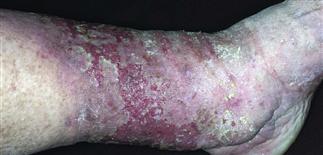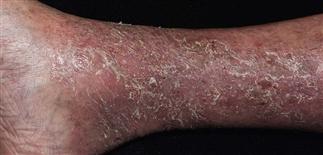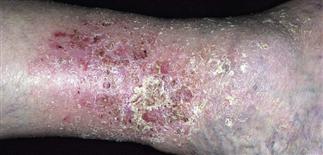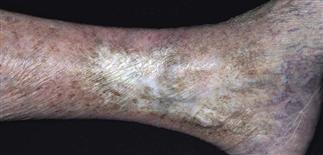18
Stasis dermatitis

Recurrent stasis dermatitis. There is striking edema, bright-red erythema, weeping and scaling.

The lower leg has circumferential erythema and scaling, with a tight appearance. The skin often feels firm. This degree of stasis dermatitis appears to be very chronic and untreated.

Subacute eczema with erythema and scale present over a wide area. Varicosities are scattered on the lower, medial foot.

Post-inflammatory changes of white, shiny scarring on the medial lower leg, and golden brown hyperpigmentation. Note the varicosities.
DESCRIPTION
An eczematous dermatitis of the legs, associated with edema, varicosed and dilated veins, and hyperpigmentation. It is chronic and commonly relapses.
HISTORY
• Often a prior history of deep venous thrombosis, surgery, leg trauma, or ulceration. • Often a family or personal history of varicose veins. • Patient complaints include heaviness or aching in the legs aggravated by prolonged standing or walking. • Legs are swollen at the end of the day. • Dermatitis and itching are a common finding and can be chronic.
PHYSICAL FINDINGS
• Dilated and tortuous veins frequently present on affected leg. • Subacute and chronic eczematous dermatitis appears on lower legs or surrounding a venous ulcer. • Dermatitis is obvious and associated with dry, fissured, erythematous skin. • Dermatitis can become generalized (auto-eczemization) if condition persists. • Edema, brown discoloration (hemosiderosis), erosion, or ulceration is common. • Troublesome pruritus; excoriation can potentiate secondary infection. • White scars, sometimes atrophic or stellate, on medial malleolus indicate previous ulceration. • Stasis papillomatosis (elephantiasis nostra) and verrucous hyperplasia found in chronically congested limbs, occurring with local lymphatic disturbances such as chronic venous insufficiency, primary lymphedema (Milroy disease), trauma, and recurrent erysipelas. • Secondary infection with Staphylococcus aureus (impetiginization) common, especially in excoriated skin. • Color duplex ultrasonography can confirm venous valvular incompetence. • If a strong family or personal history of multiple deep vein thrombosis, check the clotting cascade (protein S, protein C, activated protein C resistance, factor V Leiden, cryofibrinogens, and homocysteine level).
TREATMENT
• Apply cool water dressings 10–20 min twice a day for acute exudative inflammation. • Apply group II–V topical steroids twice a day (cream if acute, ointment if chronic) for 2–3 weeks. • If indication of infection, administer Domeboro (aluminium subacetate) wet dressings and a course of oral antibiotic according to culture and sensitivity. • For generalized dermatitis (auto-eczematization), treat with an oral corticosteroid with 3-week taper. • Oral antihistamines (e.g. hydroxyzine) 10–25 mg every 4–6 h as needed may help control itching. • Lubricate with bland emollients daily. More Vaseline-like bases—such as plain petrolatum, Aquaphor, Aveeno, Cetaphil cream—are preferable to lotions. Many popular moisturizers contain fragrance and preservative ingredients that may result in contact allergy. Simplify topicals. • Compression (20–30 mmHg) with stockings (e.g. Venosan, Sigvaris, Jobst or Ace wraps). More aggressive compression (30–40 mmHg at the ankle) may be required.







